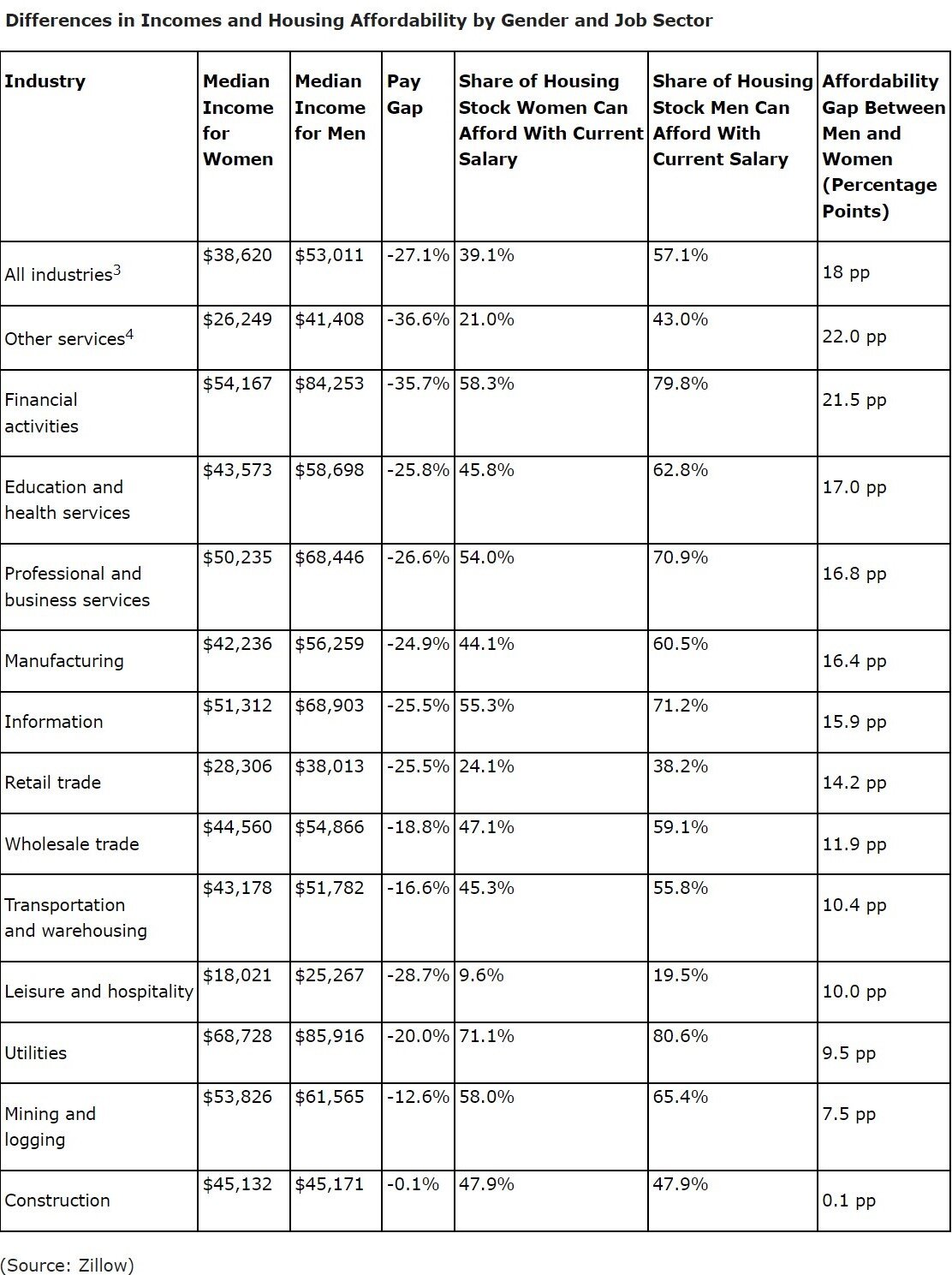Residential Real Estate News

Women Could Afford 18 Percent More Homes if Pay Was Equal to Men
Residential News » New York City Edition | By WPJ Staff | March 31, 2022 8:30 AM ET
A new Zillow Housing study shows how severe an impact the gender pay gap is for women in the housing market. An additional 18% of the U.S. housing market is affordable to men but is out of reach to women. This gap in access can be as wide as 22% of the housing market depending on the industry they work in.
The analysis combined income data from the U.S. Census Bureau with Zillow housing data to estimate how much of the market is affordable to women and men. The study examined a number of job sectors and regions and found that across the country, women can afford far fewer homes than men without being considered cost burdened.
"This study shows how severely the gender pay gap limits women in the housing market, but that's only the start of a compounding impact," said Zillow economist Nicole Bachaud. "Owning a home represents the dominant form of wealth building for most Americans. So not only are women starting from behind, but they're falling even further behind with each passing day as homes build equity."
The impact of income inequality on housing affordability differs by industry. For example, women who work in the utilities industry have more homes available to them (71.1% of the market) than women working in all other industries analyzed. Women working in the leisure and hospitality industry can only afford 9.6% of the market. Men in both industries can afford 9-10 percentage points more of the market than women. In all 13 job categories analyzed nationally, men can afford more of the housing stock than women.
Regionally, gender disparities by industry can become even more severe. In Denver, for example, women working in the financial services industry can reasonably afford fewer than one in five (19.1%) homes in the area, while men can expect to afford more than two-thirds (71.1%). In Portland, Oregon, the numbers for the financial industry stand at 13.9% of the market available to women and 66.0% to men.
Equal Pay Day -- which symbolizes how far into a new year a woman making a typical salary needs to work to make the same amount of money as a man making a typical salary in the previous calendar year -- shows that the pay equity gap is slowly shrinking. This year, Equal Pay Day fell on March 15, nine days earlier than it did in 2021 and 16 days earlier than in 2020. Simultaneously, the home value gap for women is also narrowing. Homes owned by female-headed households, although still below the value of those owned by male-headed households and of median home values overall, have crept closer to parity over the past decade.
"The drive to eliminate pay inequity and other biases in the workplace needs to come from senior leaders with clear and measurable goals," said Bachaud. "Taking actions like regularly evaluating salaries or reevaluating other HR benefits and policies to attract and retain women could help reduce disparities."
While the tide is starting to turn, there remains much work to do to achieve pay equity, especially when taking race into account. For Asian American and Pacific Islander women, Equal Pay Day (relative to the typical pay for white men) is May 3; for Black women, it's September 21; for Native American women, it's November 30, and for Latina women, it's December 8.
Sign Up Free | The WPJ Weekly Newsletter
Relevant real estate news.
Actionable market intelligence.
Right to your inbox every week.
Real Estate Listings Showcase
Related News Stories
Residential Real Estate Headlines
- Las Vegas Area Home Prices Uptick 4.3 Percent Annually in March
- Single-Family Rent Growth in U.S. Trends Upward in 2025
- U.S. Mortgage Rates Tick Down Post Trump Tariffs Commencement
- President Trump's 'Liberation Day' Tariffs Potential Impact on the U.S. Housing and Mortgage Markets
- Baby Boomers Biggest Cohort of U.S. Home Buyers in 2025 as Millennials Decline
- U.S. Monthly Housing Payments Hit Record High in 2025
- U.S. Pending Home Sales Uptick in February
- Global Prime Residential Rent Slowdown Continued in Late 2024
- Ireland Home Price Inflation Hits 8 Year High in Early 2025
- Existing Home Sales in America Uptick in February
- Great Miami Area Residential Sales Decline 15 Percent Annually in February
- Mortgage Rates Uptick in Mid-March, Ending 9-Week Decline in U.S.
- World Property Ventures Builds the Future of Real Estate with New Funding Round
- U.S. Builder Sentiment Declines Amid Economic Uncertainty and Rising Costs
- Black Homeownership Rates in U.S. Enjoy Largest Annual Increase of All Racial Groups
- Wealthy Renters Are Taking Over More of the U.S. Rental Market
- If U.S. Congress Does Not Extend NFIP Soon, Thousands of Daily Home Closings Impacted
- U.S. Mortgage Applications Spike 11 Percent in Early March
- Greater Palm Beach Area Residential Sales Rise in Early 2025
- New Apartments in U.S. Are Leasing at Slowest Pace on Record
- U.S. Mortgage Rates Drop to 4 Month Low in March
- Overall U.S. Mortgage Delinquency Rates Dip in December
- New Tariffs on Canada, Mexico to Impact U.S. Homebuilder Input Costs
- Monaco's Property Market: A Tale of Two Cities
- U.S. Home Purchase Cancellations Surge, 1 in 7 Sales Getting Canceled
- U.S. Pending Home Sales Hit Historic Low in Early 2025
- Greater Miami Area Residential Sales Dip in January
- Governor DeSantis Supports Ending Property Taxes in Florida
- WPV Aims to Become the Berkshire Hathaway of Real Estate Tech
- U.S. Home Sales Slump Continues in January
- Average Americans Spend 38 Percent of Monthly Income on Mortgage Payments
- Switzerland's Safe-Haven Appeal Grows with World's Wealthy Homebuyers
- U.S. Builder Confidence Rapidly Declines in February
- Las Vegas Home Sales Rise 6.7 Percent Annually in January, Condo Sales Dip
- Homebuyer Demand in America Drops to 5-Year Low in Early 2025
- Ownership More Affordable Than Renting in Most U.S. Markets
- The World's First Global Listings Service Launches, Called a GLS
- Home Prices Continue to Rise in 89 Percent of U.S. Metros in Late 2024
- Global Luxury Residential Prices Showed Gradual Improvement in Late 2024
- U.S. Construction Hiring Rate Drops to Lowest Levels in 5 Years






